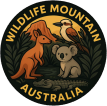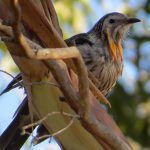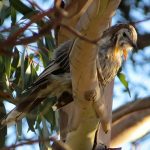YELLOW WATTLEBIRD
The Yellow Wattlebird is notable for its striking appearance. It has a long, slender body and measures about 37 to 48 centimetres in length. Its plumage is predominantly grey-brown with white streaks, giving it a somewhat mottled look. The most distinctive features are the long, fleshy, yellow wattles that dangle from either side of its face, which become more pronounced as the bird matures. These wattles, along with their bright yellow belly, are key identifiers. The Yellow Wattlebird is one of the few birds with wattles, fleshy appendages that are believed to play a role in courtship and social interactions.
This bird is endemic to Tasmania, meaning it is found nowhere else in the world. It prefers open woodlands, forests, and heathlands, particularly those with an abundance of flowering plants, which provide ample feeding opportunities. Its role in pollination is vital for the health of its ecosystem, aiding in the reproduction of native plants.
The Yellow Wattlebird is known for its loud and raucous calls, which can be heard echoing through its habitat. Its vocalisations are varied, including a harsh, repetitive “yak-yak” or “coughing” sound that can be quite startling. These calls are often used to communicate with other wattlebirds and to establish territory.
As a honeyeater, the Yellow Wattlebird primarily feeds on nectar from a variety of flowering plants. It plays a crucial role in pollination. In addition to nectar, it also consumes insects and some fruits, which provide additional nutrients. Despite their size and loud calls, Yellow Wattlebirds can be surprisingly elusive, often blending into the foliage of their woodland habitats.
Breeding season for the Yellow Wattlebird typically occurs from August to January. During this time, they build cup-shaped nests high in trees, using twigs and lined with softer materials like feathers. The female lays two to three eggs, which she incubates while the male helps by bringing food. Both parents participate in feeding the chicks once they hatch.
While specific data on the longevity of Yellow Wattlebirds in the wild is limited, honeyeaters generally have a lifespan of around 5 to 10 years, depending on environmental conditions and threats.
The Yellow Wattlebird is currently not listed as threatened. However, like many species, it faces challenges from habitat destruction and climate change, which can impact food availability and breeding success.
Predators of the Yellow Wattlebird include larger birds of prey, such as hawks and owls, as well as introduced species like cats. Nestlings and eggs are particularly vulnerable to predation.
The Yellow Wattlebird is a wonderful example of Tasmania’s unique biodiversity, and its presence is a reminder of the intricate connections within natural ecosystems. By understanding and appreciating these birds, we can foster a greater desire to protect their habitats and ensure their survival for future generations.


